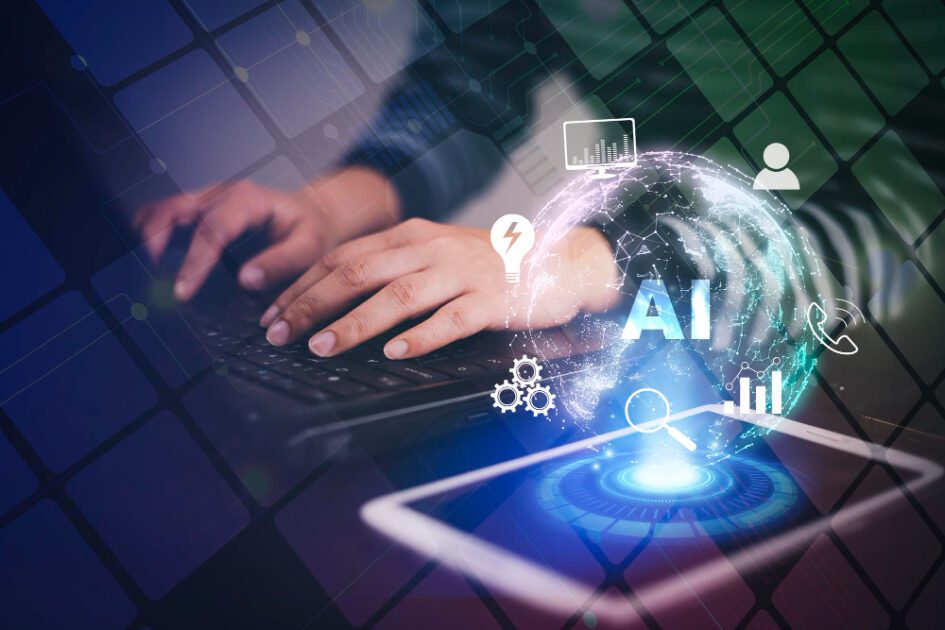Artificial Intelligence as a Service (AIaaS) is a modern technology enabling businesses to experiment with AI and implement it in various industries and purposes.
Services such as these are relevant today, with the huge wave of AI at its peak promising a brighter future.
However, AI is still not fully evolved, and people have yet to experience its power in their personal and professional lives. This is why many organizations are not willing to invest in AI presently.
In addition, the lack of resources, infrastructure, skill, and time also gives a setback to organizations wanting to develop their own AI tools in-house.
AIaaS is a blessing for organizations like these. It helps in building simple, scalable, and highly adaptable customized AI services. This could result in increased AI adoption.
In this article, I’ll discuss AIaaS and how you can truly unlock its power and leverage it in your business.
What Is AIaaS?
Artificial intelligence as a service (AIaaS) is a cloud-based technology that cloud providers leverage to create advanced applications and services and then outsource them to businesses.

This means businesses don’t have to create these sophisticated services and tools in-house by themselves or invest in them significantly. Instead, they can get an AIaaS tool from the cloud provider by paying for the subscription.
In the past, developing AI solutions in-house for many businesses was costly due to a shortage of advanced infrastructure, skilled developers, and resources to support research.
AIaaS services are best suited for these companies and working individuals who want to leverage AI into operations but cannot truly afford to create an AI tool all by themselves. Instead, organizations can invest in subscriptions to get these AI tools through the AIaaS model. This makes the process quickly accessible, customizable, scalable, and flexible.
Now companies can develop their own AI models and tools for their needs, but that comes with its unique challenges, such as:
Today, AIaaS usage has increased in various sectors, from IT to healthcare, finance, banking, and more, and it’s expected to increase more.
How Does AIaaS Work?
Cloud providers such as Google, Microsoft, and Amazon leverage AIaaS technology to create useful applications, services, and tools that various types of businesses from different industries can utilize by paying the providers some fee or taking a subscription.

To avail of such AI services, companies or individuals do not need to develop any in-house system. This helps them save plenty of time, resources, and money.
With AIaaS, companies can introduce the power of AI in their business operations and workflow using the AIaaS tool they paid for through subscription. This way, businesses can use the tool whenever they want as long as they pay for it and access it quickly since everything is on the cloud.
The cloud provider manages the access of the companies to the services through SDK or API connections. AIaaS providers host these AI tools and manage everything, from development, testing, and maintenance to deployment.
Advantages of AIaaS
Cost Saving

Using AIaaS services does not require businesses to make heavy initial investments. It is cost-effective for businesses because you only need to pay for the AI services you will use for as long as you want instead of making a huge investment in building it in-house.
Hassle-Free Deployment
Companies want something easy and quick, and AIaaS does exactly that. It is one of the swiftest ways to introduce AI in any organization. It supports effortless deployment of customizable AI tools in a business’s workflow to meet unique needs.
Automation
With the help of AIaaS, tasks like scheduling meetings, responding to similar queries, etc., can be automated. This saves money, effort, and time significantly.
Minimizing Tech Skill Dependency
With AIaaS, organizations don’t need skilled tech experts to create sophisticated services and run all operations manually.

The platform comes truly handy to take care of these. It helps cloud providers create applications quickly and deploy them to businesses that can use them effortlessly. Moreover, the no-code framework integrated into AIaaS substantially enhances the company’s resources.
Increased Accessibility
AI as a Service (AIaaS) helps enhance accessibility since everything is on the cloud that you can access quickly on your computer or smartphone with a few clicks. You can use AI-powered tools and services without having to understand the nitty-gritty details. This also increases accessibility because you can tap into AI’s potential without a steep learning curve.
How AIaaS Accelerates Application Development?
Software and app development will rely more on AI in the future. Software development involves certain repetitive tasks like testing, code reviews, scheduling meetings, distributing tasks, debugging, etc.

With the use of AIaaS pre-trained models, employees could spend less time on these tedious tasks. They can simultaneously allocate resources, workforce, and time to important tasks. This accelerates the software development lifecycle.
Previously, developers had to write heavy chunks of code to add functionalities to the app or running operations. However, using AIaaS streamlines everything. Some AI tools enable developers to become more productive in their jobs with the help of machine learning and data science.
In addition, you can use accessible coding templates using AIaaS without having to write everything from scratch.
While most SMEs lack the resources to build AI tools for their operations, AIaaS helps them explore a whole new arena of modern software development. By using AIaaS, organizations can now achieve higher application performance with reduced development costs and enhanced efficiency.
Most importantly, the complete digital transformation of the application development process with technologies like AIaaS is highly useful for security upgrades of the software.
How AIaaS Reduces Upfront Investment?
In-house development of AI tools would cost a company huge resources in terms of high-performance hardware; hiring specialized skilled AI developers and accessing these AI tools through the AIaaS will scale down this cost.

AIaaS follows the subscription model for monetization. By providing access to AI services through the subscription model, AIaaS helps reduce upfront investment by businesses.
In this model, the company that uses the AIaaS-powered tools (provided by a third-party company) pays a fee monthly, annually, or half annually in order to continue using the tools. This is advantageous for businesses using AIaaS since upfront investment costs on building the applications are eliminated.
Such expenditures are a significant barrier for small and medium-scale industries. AIaaS is an extremely cost-effective alternative for organizations to access AI infrastructure and tools and pay for it on a subscription popularly called the pay-as-you-go model.
Accessibility to AIaaS reduces not only the upfront investment but also the predictable operating expenses of the companies. Since AIaaS works in a subscription mode, organizations can accurately predict their estimated spending on the usage of AI tools.
As we talk of AIaaS working on the subscription mode, it encompasses software infrastructure, support, and maintenance costs of the service as well.
How AIaaS Helps Developers Work Across Domains With Reduced Complexity?

Transcending boundaries across domains is probably a pivotal node of the modern tech development world. AIaaS empowers developers to accelerate the development process and make it hassle-free by imbibing the power of AI in their development process, even without substantial expertise in each domain.
AI enhances the quality of application development, making it intuitive and intelligent. AI rests primarily on three subdomains – machine learning, language processing, and computer vision. It is quite tough for developers to have professional expertise equally in each of these fields.
To this, AIaaS allows developers to leverage AI in development even without being specialists in all domains. AI tools can also facilitate the judicial allocation of resources and complexity in each field. Plus, AIaaS helps in enhancing the agility and iteration rate of project development through rapid prototyping.
Furthermore, software testing has now become easier with the help of preconceived testing templates available on certain AIaaS platforms. AI is absolutely versatile and is a perfect game changer for developers who are willing to explore innovative cross-domain solutions for software development.
Some of the most popular AIaaS service providers are:
- Amazon Web Services: Also called AWS, it is one of the most prominent services providers of AIaaS. It offers 200+ services, including AI-based solutions.
- Google AI: It is a web product by Google Cloud. Google also offers several other products and services based on AI technologies, such as Google Lending DocAI.
- Microsoft Azure AI: Azure NLP from Microsoft is a popular AI platform that uses machine learning and data science.
Other well-known vendors are:
- IBM Watson
- MonkeyLearn
- Alibaba Cloud
- ServiceNow
- OpenAI
- Salesforce
Industries Using AIaaS
AIaaS is starting to become a dynamic, transformative force across several industries. The ready-to-use cloud-based solutions offered by AIaaS make them ideally perfect for usage in several industries, such as the following:
#1. Healthcare
From enhancing the quality of patient care to driving tech-led medical innovations, AI is spreading its wings in the healthcare industry. Several tools from popular AIaaS help in processing and analyzing large-scale genomic data, identifying any medical image anomalies obtained through X-rays and MRI screening.
#2. Banking and Finance

Fraud detection and risk management have become easier with the predictive power of AI. AIaaS offers numerous tools that make the screening process in the finance sector much more stringent and also facilitate the process of making better investment plans.
#3. Software Industry
AIaaS helps in the faster and more accurate development of several software and applications. Multiple AI-driven analytics and services drastically reduce the inefficiencies in production. This enables the swift development of user-friendly, effective, feature-rich software solutions.
Other than that, AIaaS also forms the operational backbone of a number of other industries:
- Energy and utilities
- Manufacturing and supply chain
- Agriculture
- E-commerce and retail
- Space science
Applications of AIaaS
Natural Language Processing (NLP)
NLP is perhaps one of the biggest and introductory renaissance of AI – empowering computers to understand, analyze, process, and respond to human languages.
The biggest use of NLP is in the creation of the trendiest Open AI GPT-3 that creates relevant content based on any human language command. Chatbots and AI-powered virtual assistants also use similar technology.
MLaaS

MLaaS stands for Machine Learning as a Service. It is a cloud-based technology like AIaaS that helps organizations create ML tools and services. It is widely used in healthcare diagnostics, app development, and fraud detection.
For example, Vertex AI is a great web product built on Machine Learning models. It is an excellent interface for tooling through pre-trained custom models. Vertex AI mostly used MLOps to manage the ML workload and also create excellent apps. Benefits such as reduction in development and training costs are the key USPs.
Computer Vision
Computer Vision utilizes AI to interpret visual information and enable image searches. The Amazon Recognition feature automates video analysis and image recognition search through AI-powered computer vision.
The customizable pre-trained computer vision API models are a great boon of AIaaS and help in analyzing and streaming images and video in no time. By using this service, companies can avail themselves of AI-managed image and video analysis without creating AI tools from scratch.
Predictive Analytics
AIaaS facilitates predictive analytics by leveraging machine learning algorithms to identify patterns in historical data, enabling organizations to forecast future trends and outcomes. This is invaluable in industries such as finance, retail, and marketing, where informed decision-making relies on accurate predictions.
For instance, AI platforms like Google AI offer predictive analytics capabilities that empower businesses to build, deploy, and monitor predictive models at scale. By integrating AIaaS for predictive analytics, companies can optimize their operations, inventory management, and customer targeting strategies.
Personalized Recommendations
AIaaS enables the delivery of personalized recommendations by analyzing user behaviors and preferences. This is widely used in e-commerce, streaming services, and content platforms to enhance user engagement and satisfaction.
Netflix’s recommendation system is a prime example of AIaaS in action. By employing machine learning algorithms, it analyzes viewers’ past interactions and preferences to suggest relevant movies and shows. Such personalized recommendations not only improve user experience but also drive customer loyalty and retention.
Robotic Process Automation (RPA)

Robotic Process Automation, often integrated within AIaaS offerings, automates routine and repetitive tasks by mimicking human interactions with digital systems. RPA streamlines workflows reduces human errors, and increases operational efficiency across various industries.
For instance, in finance, RPA can be used to automate data entry, invoice processing, and reconciliation tasks. By incorporating RPA (as a part of AIaaS), organizations can achieve significant time and cost savings while redirecting human resources toward more valuable activities.
Emotion and Sentiment Analysis

AIaaS solutions offer emotion and sentiment analysis, a powerful tool for understanding customer feelings and opinions. By analyzing text, audio, or video data, AI can determine the emotional tone behind interactions, enabling businesses to gauge customer satisfaction, detect potential issues, and refine their strategies.
This is greatly valuable in industries like marketing and customer service.
For example, companies can use sentiment analysis to monitor social media conversations and adjust their campaigns in real-time. Integrating this capability through AIaaS empowers businesses to make informed decisions that resonate with their audience, enhance brand perception, and ultimately drive business growth.
Conclusion
As the AIaaS landscape continues to evolve, staying informed about the latest advancements and best practices will be crucial for maximizing its benefits. Adopting AIaaS can empower businesses to unlock new efficiencies, drive innovation, and gain a competitive edge in the market.
By 2030, the AIaaS market will expectedly reach a peak value of $43.29 billion USD with annual growth of 25.8%. AIaaS is a rapidly expanding industry, and it’s showing all the signs of a bright, promising future.
You may also explore the differences and applications between predictive AI and generative AI.

